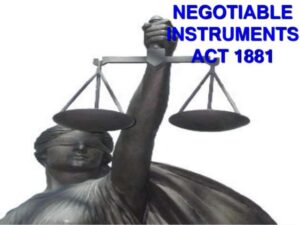
Section 13(a) of the Act says that a “negotiable instrument” is a promissory note, bill of exchange, or check that can be paid to either “order” or “bearer,” even if the words “order” or “bearer” are not printed on the instrument.
Some important things about negotiable instruments are:
Property: The person holding a tradable paper is recognized as the owner of the property inside it. Not only does a negotiable document give ownership of itself, it also gives the owner the right to property. In a movable paper, the property can be changed without any necessary steps. When there is a bearer device, the goods are given to the new owner by mere delivery. If you have an order device, you need to sign it and give it in order to move property.
Title: The person who receives a movable paper is known as the “holder in due course.” Anyone who legally receives something for value is not affected by any problems with the title of the person who transferred it or anyone who owned it before them.
Rights: If someone breaks a movable instrument, the person who received it can go to court in his own name. A tradable object can be given to someone else many times until it matures. The person who owns the instrument doesn’t have to tell the party formally responsible for paying the instrument that it has been transferred.
Assumptions: Some assumptions are true for all tradable documents, like the one that says that due diligence has been done on the document. In a promissory note, you don’t have to write the words “for value received” or something similar because the payment of the consideration is enough. Most of the time, the words are added to provide more evidence of thought.
Quick payment: A flexible instrument makes it easier for the user to expect quick payment because dishonor means that everyone who is party to the instrument loses their credit.

